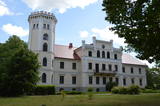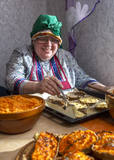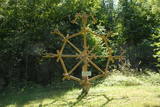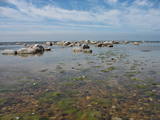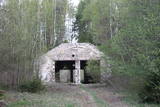| Нo | Название | Описание |
|---|---|---|
|
Этот тур предлагает вниманию путешестенников самые изысканные объекты культурного и исторического наследия, оставленного на протяжении нескольких веков — средневековые замки, различные поместья и восхитительные дворцы. Маршрут частично проходит через Национальный парк Гауя с отличными видами на луга и старинный лес, где фермерские хозяйства живут по своим неизменным устоям. Живописная дорога соединяет три замка — Сигулду, Турайду и Кримулду, расположенных на высоких берегах долины реки Гауя. Далее маршрут идет через одну из старейших церквей в Латвии и направляется в сторону двух примечательных поместий 19 века — Бирини и Игате. На следующий день отдохните с шиком в поместье — гостинице Дикли. Маршрут следует дальше, через очаровательный средневековый город Цесис с величественными руинами замка и новым замком вблизи. Вторая часть тура охватывает кольцо примечательных замков и дворцов в Земгале. Она включает в себя Яунпилский Замок, который незначительно изменился со времен средневековья, руины замка в Добеле и старинное городище в Тервете. Недалеко друг от друга находятся Баусский замок 15 века, стратегически расположенный между двух рек, Дворец Межотне в классическом стиле и самая знаменитая жемчужина Балтии - великолепный Рундальский Дворец в стиле барокко и рококо, окруженный французским парком. |
||
|
Skaistā ēka atrodas Lizuma centrā. Lizuma muižas īpašumi piederējuši dažādām dzimtām – vācbaltiešiem Tīzenhauzeniem, Malamiem un Volfiem. 1836. g. muižu iegādājas barons Otto Gotlībs fon Volfs, kura laikā muižas pils iegūst tagadējo veidolu – Tjudoru neogotikas stilu ar poligonālu torni. Jau no 1937. g. pilī izvietojusies Lizuma skola, kas ir viens no iemesliem, kādēļ saglabājusies ne tikai pati ēka, bet arī atsevišķi interjera elementi kāpņu telpā, Zilajā (Mednieku) zālē u.c. Pili ieskauj parks, kur atrodas muižas saimniecības ēkas – mūra klēts (te kultūras nams), 1876. g. celtais zirgu stallis (sporta halle), kalpu un dārznieka namiņš u.c. Bijušajā spirta brūzī ražo Gotiņas konfektes. Pils tornī izveidots Lizuma vidusskolas veidotais novadpētniecības muzejs. |
||
|
Laidze Parish Farm "Cukuriņi" is engaged in sea buckthorn cultivation. The farm covers about 10,000 sea buckthorns on an area of 6 hectares. The fields are treated with a computerized irrigation system. The owners of the grown berries both sell and process it themselves, obtaining sea buckthorn juice, oil and frozen berries. |
||
|
Деревенский дом, в котором вас встретит настоящая латышская хозяйка Скайдрите Наглиня и продемонстрирует традиции выпекания хлеба по унаследованному от предков рецепту. |
||
|
Folkloras taka "Jāņkalni" iepazīstina ar mūsu senču rakstiem, zīmēm un dievībām, kas ir mūsu folkloras mantojums. Folkloras takas (garums: apm. 1,5 km vai 2 stundas) mērķis ir arī iepazīstināšana ar senlatviešu ieražām, folkloru, kā arī tautu dainu izprašana. Piedāvā iziet Latvijas karti - labirintu ar 19 etnogrāfiskajiem novadiem. Gids Jums sniegs izsmeļošu stāstījumu un atbildes uz interesējošiem jautājumiem.
|
||
|
Крестьянское хозяйство «Межацирули» основано 1992 году. Хозяйство находится в Елгавском крае Залениекской волости, в водозборном бассейне Лиелупе. В начале деятельности площадь хозяйства была 7,2 га; в хозяйстве было три коровы, 20 овец и 6 свиноматок. Сейчас в хозяйстве 700 га земли, 300 дойных коров, комплекс теплиц, в которых выращиваются салат и пряные растения. |
||
|
Der weiteste Nordpunkt der Juminda Halbinsel mit einer Raketen-Attrappe der Sowjetarmee, der alten Grabstätten, dem Juminda-Leuchtturm und einem Denkmal für die Opfern des Zweiten Weltkriegs. |
||
|
Кузница находится на территории комплекса средневекового замка Цесу. Здесь можно посмотреть, заказать и приобрести украшения, подобные старинным, понаблюдать за работой мастера и послушать увлекательный рассказ об истории изготовления украшений, и самим испытать их «на своей коже». |
||
|
В старой кирпичной печи готовят глину, которую используют многие керамисты Латвии. Тут же на производстве делают (ручная работа) полезные в хозяйстве вещи и предметы дизайна. Проводят экскурсии, увлекательно рассказывают, организуют творческие мастерские и принимают индивидуальные заказы. |
||
|
Für den Zweck der Bewirtschaftung der Niederungsauen des Pape-Sees und der Vermehrung der biologischen Vielfalt sind hier Konik-Wildpferde angesiedelt wurden. Die kann man mit einem örtlichen Guide kennenlernen. |
||
|
Мы начинаем тур в Риге, на автобусе, и продвигаемся по берегу Балтийского моря, проезжая через множество различных ландшафтов — белые песчаные пляжи, прибрежные луга, дюны с крутыми берегами и сосновыми лесами. Многие пляжи до сих пор безлюдны и практически пустынны. Доступ на эти территории был строго ограничен в советское время. Маршрут идет через этнографические рыбацкие деревни в Ниде, проходя через природный резерват Папе, где разводят диких лошадей. Шумный город Лиепая впечатляет своим оживленным променадом и музыкальным окружением. Город также славится своей длинной военной историей, которую нельзя не заметить, прогуливаясь между морскими фортовыми укреплениями и посетив бывший военный городок. В содержащемся в образцовом порядке Вентспилсе увидите славный рынок, замок и многочисленные парки. Стоит посетить отреставрированную узкоколейную железную дорогу с действующим паровозиком , а также Дом Ремесел — идеальный для покупки местных сувениров ручной работы. На обратном пути маршрут идет через красивый провинциальный город Кулдигу с хорошо сохранившейся деревянной архитектурой. Тур включает в себя посещение двух наиболее интересных национальных парков: Слитере, хранящий геологическую историю былых веков, и Кемери, с его удивительной вересковой тропой и серными источниками. |
||
|
Витрупе – Туя - территория важна для охраны рифов. Она расположена напротив Салацгривского края, ее площадь составляет 3577 га. В территорию входит морская часть природного заказника «Видземское каменистое побережье».
|
||
|
Алейская хлебопекарня и гостевой дом расположены в 0,5 км от центра Руцавы. Здесь в дровяной печи пекут хлеб на натуральной закваске. Различные сорта ржаного хлеба (обыкновенный ржаной хлеб, ржаной кисло-сладкий хлеб с добавками и без них, ржаной хлеб с сухофруктами и др.), чесночные сухарики, а также разные виды белого хлеба. По предварительному заказу можно приобрести продукцию навынос. |
||
|
В трудно доступном месте в Бартских лесах расположена Планциемская ракетная база – особый военный объект бывшего СССР. Объекты базы снесены с целью получения строительных материалов.
|
||
|
В «Риекстини» Нереты шесть лет своего детства провел выдающийся латвийский писатель и художник Янис Яунсудрабиньш (1877 - 1962). Я. Яунсудрабиньш родился в семье слуг «Кродзини» Нереты, а в «Риекстини» с матерью переехал после смерти отца. Люди, жившие в «Риекстини», стали прототипами героев его «Белой книги», в которой этот дом называют «Наш дом». В память о Я. Яунсудрабине в 1967 году в Риекстини был открыт музей, который находится в аутентичном хуторе Селии со своим особым духом и ароматом. Можно осмотреть жилой дом, амбар и каретник. В яблоневом саду «Риекстини» есть столетние и более старые яблони. На кладбище Кишку (у дороги Вецумниеки - Илукстес), расположенном неподалеку, похоронены члены семьи Яунсудрабиней и перезахоронен сам Я. Яунсудрабиньш. В Неретском краю сохранилось много хуторов и имен собственных - названий холмов, рек и других мест, упомянутых в «Белой книге» Я. Яунсудрабиня. |
||
|
Eine einzigartige Kirche mit einem im 17. Jh. beiseite gebauten Glockenturm. |
||
|
Науенское городище находилось на крутом правом берегу долины Даугавы на высоте 25 м, между двумя оврагами. Под руководством магистра Ливонского ордена Эрнеста фон Раценбурга в 1275 - 1277 гг. на месте прежнего латгальского деревянного замка возводится каменный замок. До середины XVI века замок служит резиденцией комтура Динабурга. В 1577 году войска Ивана Грозного полностью разрушили замок. После этого события Динабург теряет свое стратегическое значение, и строительство новых укреплений начинается в том месте, где сейчас находится Даугавпилс.Рядом с развалинами замка ордена установлен уменьшенный макет замка. С места автостоянки до городища можно дойти по тропе. С городища открывается один из красивейших видов на изгибы Даугавы. |
||
|
Единственный в Латвии советский военный объект такого вида и масштаба – часть дальней связи, которая была предусмотрена для поддержания связи с кораблями и подводными лодками Советской армии во всех (?) морях и океанах мира. В центре располагалась одна, а по периметру шесть вышек на высоте 200 м. В наше время сохранились некоторые из них, которые используются операторами мобильной связи. Ходят слухи, что комплекс так и не был ни разу включен. Великолепно просматривается Упишкалнский комплекс с дороги Скрунда – Кулдига, какие-то 3 км перед объездной Кулдигской дорогой (населенный пункт - Райдстация).
|
||
|
The Ferris wheel that is in Sigulda is on the corner of Leona Paegles and Cēsu streets, and it is only open during the summer. If you ride the wheel, you can take lovely snapshots of the ancient Gauja River valley. |
||
|
В ресторане, стоящем на берегу красивого озера Пюхаярв, что в Южной Эстонии, Вы сможете попробовать приготовленные шеф-поваром первоклассные блюда. Используются преимущественно свежие местные продукты. Также организуются специальные кулинарные мероприятия. |
||


